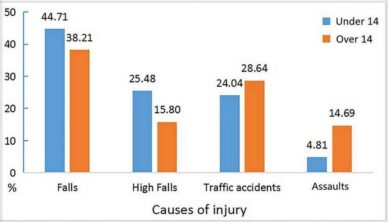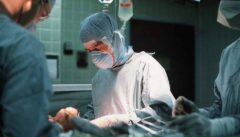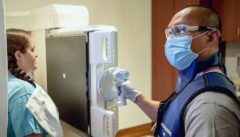Contents
Who Suffers From Facial Trauma?

The answer to our question is, of course, that anyone can experience facial trauma, regardless of age, gender, or location, but there are identifiable patterns.
The chart above comes from a detailed study on the incidence of maxillofacial injuries in China. While there are some regional differences, the general trends observed are similar across many parts of the world.
Traffic accidents are frequently cited as a major cause of facial injuries and are significant contributors. However, falls are the leading cause of facial injuries in most countries, including those in Europe and the US.
In parts of North Africa and the Middle East, conflict and terrorism have been primary causes. Sports injuries are notable in some regions, and traffic injury rates vary depending on the extent of enforced safety legislation.
Nevertheless, the major contribution of falls remains evident across much of the globe, alongside several other contributing factors.
Evident Patterns
A high incidence of facial injuries among the 6 to 11 age group in the Chinese study is consistent with findings from other regions. This age group is typically when children are becoming more independent but have not yet developed sufficient safety awareness.
Gender is also a significant factor, with males being 2 to 3 times more likely to suffer maxillofacial injuries than females in nearly every region. One area of divergence lies in the rates of injury seen at different adult ages.
In most parts of the world, injury rates spike around the ages of 21 to 28. This pattern holds even in places where violent trauma is less common; in most countries, falls are the leading cause of injury in this age group.
According to data from the Global Burden of Disease Study, the relative incidence of injuries only catches up in those over 80, if at all. The way older adults are treated or regarded in different societies can influence these outcomes.
Generally, the belief that fall-related injuries increase with age is not fully supported by the data. While this may be true for the elderly, younger adulthood remains a prime danger zone, given the different population sizes at these ages.
Prevention Matters
Countries that enforce seat belt laws, helmet usage, and drunk driving prevention are clearly more successful in reducing facial trauma. These regions also tend to have better traffic management and public education programmes.
Similarly, health and safety legislation that is effectively enforced plays a significant role in reducing accidents. Wearing protective helmets and preventing falls is essential, particularly in workplaces, sports, and leisure activities.
The supervision of both work and leisure activities by trained staff is crucial in reducing risky behaviour and passing on valuable safety knowledge.
Access to medical care also makes a difference. Individuals with pre-existing dental or facial conditions are more vulnerable to severe injury, and good overall health and vision help to prevent accidents.
After the Event
While preventing accidents is a key factor in reducing maxillofacial trauma, they are inevitable. What happens after the event can significantly influence the outcome.
A large proportion of facial trauma cases also involve damage to other parts of the body. It is vital to have the right skills and expertise available to address these injuries, particularly those involving the face.
Inadequate care can result in issues such as facial asymmetry, disfigurement, nerve damage, numbness, and loss of function—such as the ability to eat or see. Failure to address airway issues could result in brain damage or even death.
As seen in regions where this care is unavailable, timely and expert treatment from an experienced maxillofacial surgeon is essential to improving outcomes.
A maxillofacial specialist can often correct many issues at a later stage, but prompt intervention is always preferable. As with many areas of medicine—whether cancer, heart disease, or other conditions—early treatment is key to saving lives and preventing permanent damage.
12 August 2023



